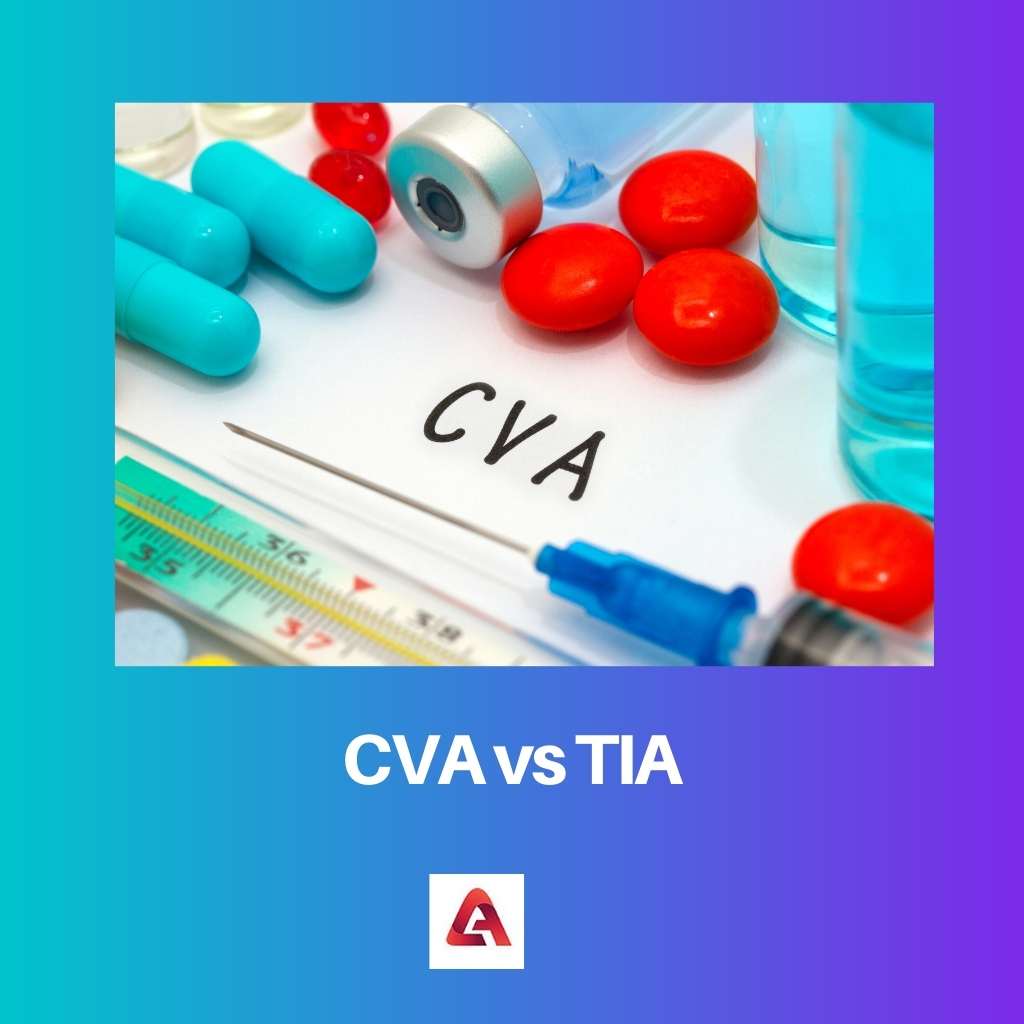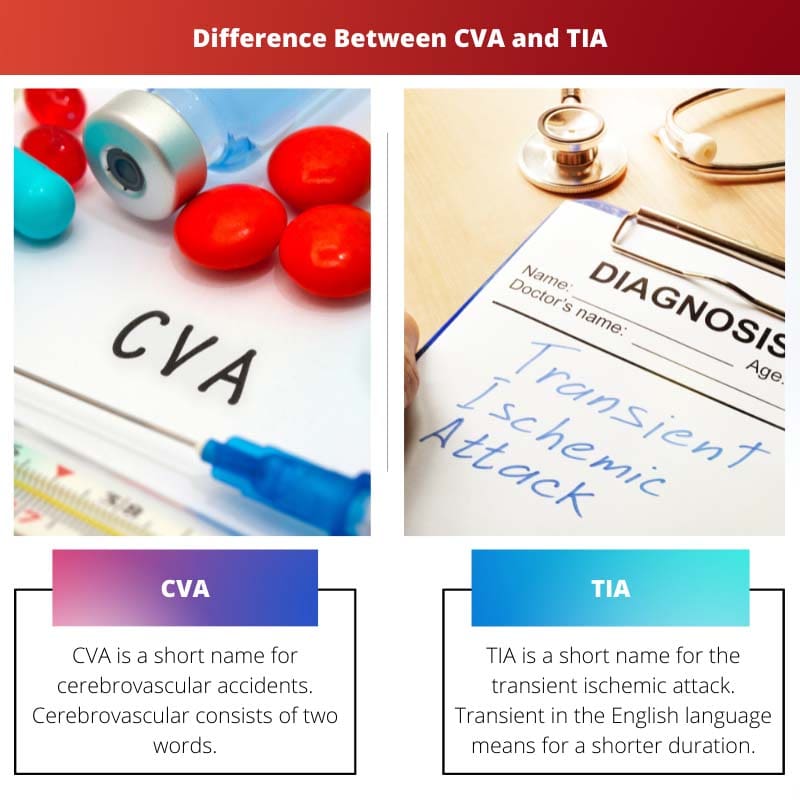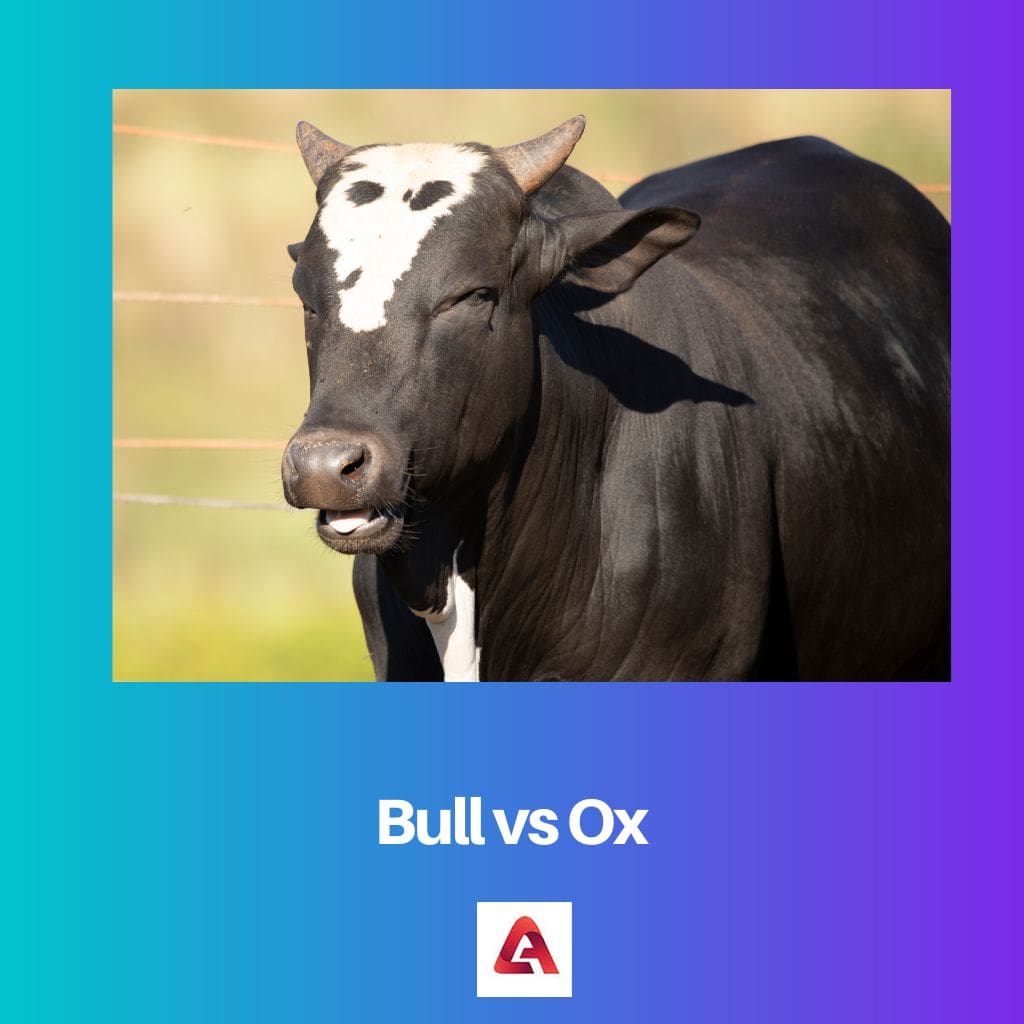Humans can experience two different strokes (blood flow in the body either ceases or reduces). Ischemic stroke is one type of stroke, while hemorrhagic stroke is another.
Ischemic stroke occurs when blood clots develop in a blood artery. However, haemorrhage stroke can occur when blood vessels burst.
CVA (cerebrovascular accident) and TIA (transient ischemic attack) are the names of strokes. CVA can be caused mainly due to ischemia condition and rarely by haemorrhage.
On the other hand, TIA takes place because of ischemic strokes.
Key Takeaways
- CVAs are permanent brain damage due to lack of blood flow, while TIAs are temporary episodes with no lasting damage.
- TIAs last a short duration, less than 24 hours, while CVAs have longer-lasting effects.
- CVA symptoms are more severe and persistent than TIA symptoms, which resolve quickly.
CVA vs TIA
CVA is a stroke caused by a blood clot or ruptured blood vessel, leading to brain damage and symptoms such as weakness or paralysis, difficulty speaking or understanding language, vision problems, and headaches. TIA is a temporary disruption of blood flow to the brain, similar to a stroke, but less severe and transient.

CVA is a stroke that attacks the brain if normal blood flow towards the brain is disturbed. It is a severe and fatal condition.
It mostly happens in people who are obese and suffer from high blood pressure. Due to the high pressure of the blood, may damage the brain.
A TIA stroke is non-fatal and non-dangerous and lasts longer than a traditional stroke. It arises due to a high cholesterol level.
In this situation, oxygen flow to the brain in the human body is disturbed. People may become temporarily unconscious due to this ministroke.
Comparison Table
| Parameters of Comparison | CVA | TIA |
|---|---|---|
| Type of Stroke | It can be either ischemic or hemorrhagic stroke. | It is an ischemic stroke. |
| Seriousness | It is a fatal stroke that damages the brain completely. | It occurs for a temporary period. |
| Cure | It immediately requires medical aid. | It can be cured with antiplatelet tablets such as aspirin. |
| Reason | It occurs due to hypertension. | It occurs due to deposits of the plagues in an artery if a person has high cholesterol. |
| Precautions | Reduce the intake of salt (sodium chloride) in the diet and work on the fitness level. | Consuming healthy meals and exercising is a great way to avoid TIA. |
What is CVA?
CVA is a short name for cerebrovascular accidents. Cerebrovascular consists of two words (cerebral means brain, and vascular means the blood-carrying vessels).
So, in simple language, if any accident happens with the blood-carrying arteries that lead to the brain, it may lead to a stroke.
This stroke can happen for one of two reasons. One of the causes is a decrease in blood flow throughout the body, particularly in the brain.
Obesity (fat deposits clog the arteries), diabetes (high sugar levels in the body can constrict the blood vessels), and high blood pressure are all causes that cause blood flow to be interrupted or reduced.
CVA can be caused by another issue, such as bleeding from fractured arteries in the brain, in sporadic cases (hemorrhagic stroke).
It could happen if the person has been in a traumatic situation or is undergoing major surgery.
It is a dangerous and fatal since people may die if timely medical assistance is not provided. The symptoms of a CVA might be simple (dizziness, vomiting) or complex (paralysis of body parts, memory loss).
Anti-hypertension and blood thinners are among the medications used in the treatment.
To avoid such accidents (cerebrovascular accidents), one must take simple precautions such as exercising, consuming a healthy diet, and saying no to smoking and alcohol.
What is TIA?
TIA is a short name for the transient ischemic attack. Quick in the English language means for a shorter duration. So, TIA is a mini ischemic attack (lack of blood supply for a shorter time).
Such attacks happen due to the sudden disturbance of blood flow in the arteries and vessels for a few minutes (less than an hour). This type of stroke is not fatal and does not damage the brain like other severe strokes.
This condition occurs when oxygen is unable to reach all the body parts in an adequate amount. Due to this, sometimes, the brain is numbed, and people might get unconscious.
Eating fatty, salty, and sugary foods causes TIA by clogging the arteries with fat deposits, as in the case of other strokes. Therefore, consuming good nutrients and exercising are keys to preventing such attacks.
Sufferers are given medicine that reduces cholesterol levels to normalize the effect. If this attack occurs for the second time, one should provide medical assistance to the patients.
Furthermore, MRI scanning does not reveal TIA as a stroke since only a tiny part of the brain is affected. However, if it happens frequently enough, it can harm the brain and result in memory loss.
Main Differences Between CVA and TIA
- CVA (cerebral vascular accident) is a formation of clots or excessive bleeding in the brain. However, TIA (transient ischemic attack) means a lack of oxygen or blood supply to the brain.
- CVA can be either an ischemic (non-dangerous) or a haemorrhage attack (emergency condition). On the other hand, a TIA is an ischemic stroke or attack, as the name implies.
- CVA occurs due to high blood pressure. However, TIA mostly occurs due to deposits of fat in arteries.
- CVA needs medical treatment immediately. On the contrary, TIA can be treated with antiplatelet medications.
- The risk of CVA can be reduced by lowering the consumption of sodium chloride. On the other hand, TIA is prevented by eating healthily.






